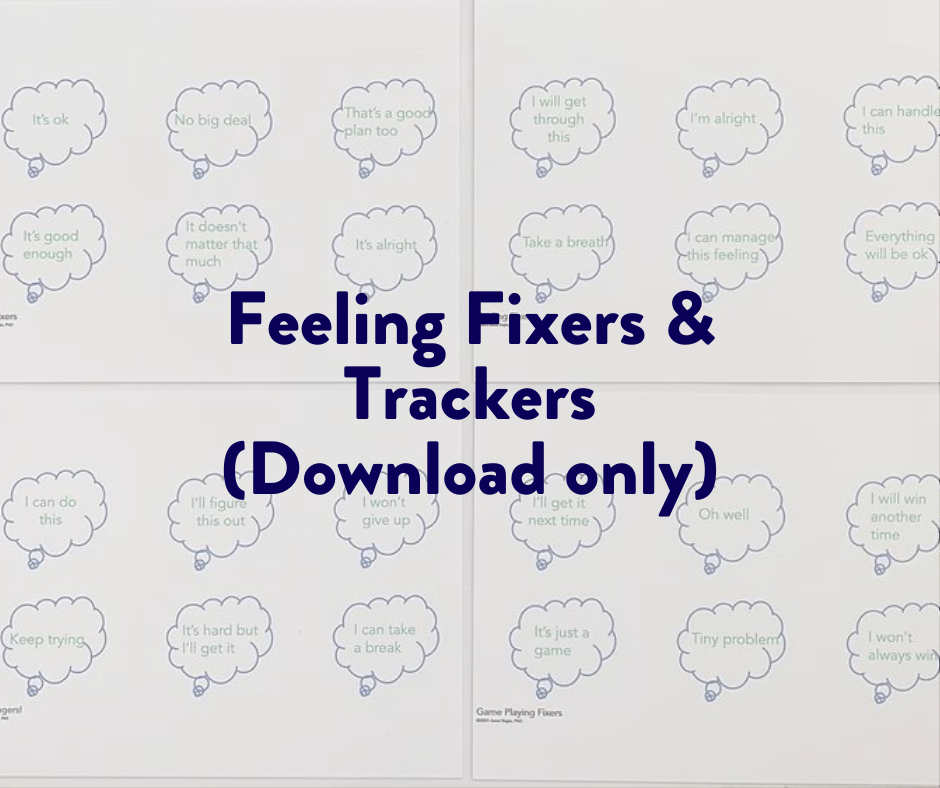 Image 2 of 2
Image 2 of 2



Feeling Fixers & Tracker (DOWNLOADS ONLY)
Downloadable PDFs of the 4 Feeling Fixers and 1 Feeling Tracker
Purchasing this bundle gives you printable versions of the 4 Feeling Fixers and 1 Feeling Tracker. I recommend affixing them to a sturdy material (e.g. taping to foam board, backing with cardboard, putting in sheet protectors, etc). Print out and share as many as you need. NO physical product will be shipped with this purchase.
Downloadable PDFs of the 4 Feeling Fixers and 1 Feeling Tracker
Purchasing this bundle gives you printable versions of the 4 Feeling Fixers and 1 Feeling Tracker. I recommend affixing them to a sturdy material (e.g. taping to foam board, backing with cardboard, putting in sheet protectors, etc). Print out and share as many as you need. NO physical product will be shipped with this purchase.
Downloadable PDFs of the 4 Feeling Fixers and 1 Feeling Tracker
Purchasing this bundle gives you printable versions of the 4 Feeling Fixers and 1 Feeling Tracker. I recommend affixing them to a sturdy material (e.g. taping to foam board, backing with cardboard, putting in sheet protectors, etc). Print out and share as many as you need. NO physical product will be shipped with this purchase.
Using the Feeling Fixers
Being human means that sometimes we will feel uncomfortable feelings. Whether feelings of anger, sadness or worry are fleeting or more longstanding, they are a fact of life. With practice, we can learn to use strategies to help manage these moments. That’s where the Feeling Fixers come in!
When our students are experiencing an uncomfortable feeling, we often support them verbally, with phrases like “Remember, it’s just a game”, etc. However, this verbal support is often not processed, or can even lead to feelings getting bigger! Showing a visual support helps students internalize these resilience-building thoughts faster. You don’t need to read them, just hold them up. During activities when you think uncomfortable feelings might come up (e.g., playing a board or video game, doing homework) prop them up nearby so they are easily available. Share them with teachers, little league coaches, grandparents, babysitters, and more! Have them in your car, take them on vacation with you, or photograph them for super-fast access.
Over time, I often ask students if we still need them out – like when we are about to play a table top game. Students will tell you when they don’t need them (usually they are right, but not always – you may need to bring them back out at some point/task), and you will often hear them sub-vocalizing the fixers – saying them “under their breath.” That means they are internalizing them – great!
One last thing to remember. We want students to realize that EVERYONE has these moments, so when you are with students, remember to model using these yourself. Driving around like crazy trying to find a parking space with your kids in the car? Take a breath and say “Wow – just no spaces right now – that’s so frustrating, we are in a hurry! Well, it’s ok, I will find one soon.” Pointing out our frustrations, as well as modeling ways to make those uncomfortable feelings smaller helps our students feel that they are not alone in their discomforts.
Feeling Fixers – general, supportive thoughts applicable to many situations
Game Playing Fixers – thoughts more specific to game playing situations
Stuck Fixers – thoughts to encourage flexibility
Encouragers – supportive thoughts to build resilience
Using the Feelings Trackers:
Many times, we don’t experience just one feeling. Feelings frequently come in combinations. We might feel sad and worried at the same time, or angry and sad, or even happy and worried (nervous). With younger children I often explain that, just like ice cream, feelings can come in scoops. The Feelings Tracker is used by a student to show their feelings in the moment, and track how they change over time.
The Feelings Tracker has 4 columns. On the far right is the happy feelings family (that includes pleased, joyful, etc.) The other three columns represent what I call the “trifecta of uncomfortable” – the sad, mad and worried feelings families. Each column has a numerical scale from 1-5, 1 being a very small feeling and 5 representing a very large (the biggest) feeling size. Just add your own small stickies. Place one at the bottom of each column. Students will move them up and down to show how they are feeling.
As students use the Feelings Tracker, it’s great to work on emotional vocabulary – helping students sort out and begin to use feeling labels that are more precise than the general feeling family name. For example, feeling names in the angry family included annoyed, frustrated, furious, explosive, etc.
Students can use this Feelings Tracker with:
story books – showing how character(s) feel
animated videos – showing how character(s) feel
During these activities, you can integrate thought bubbles, asking students what they think the characters might be thinking. I often ask students “If you were their friend, what might you say to help them feel better?” This works on empathy, as well as priming students for using these phrases to help themselves. As you work, reinforce the idea of how much the character feelings are changing – sometimes very quickly.
Students can also use this Feelings Tracker with:
themselves – showing how they are feeling in the moment
During these activities, I usually pause the activity when a feeling reaches 3. That’s a good time to check in with the student, expressing curiosity about the change in feeling size and exploring with them what might help that feeling decrease. With the student, explore which strategies in the student’s regulating toolbox might be helpful, such as taking a deep breath or drinking some water. The Feeling Fixers (included in your downloadable bundle) also work well, since they provide a visual cue of cool thoughts that can lower uncomfortable feelings.
Keep in mind that large feelings don’t easily move down all the way to okay! Whatever strategy the student applies, we want the uncomfortable feeling to get smaller – moving from a 4 to a 2 represents excellent change!
